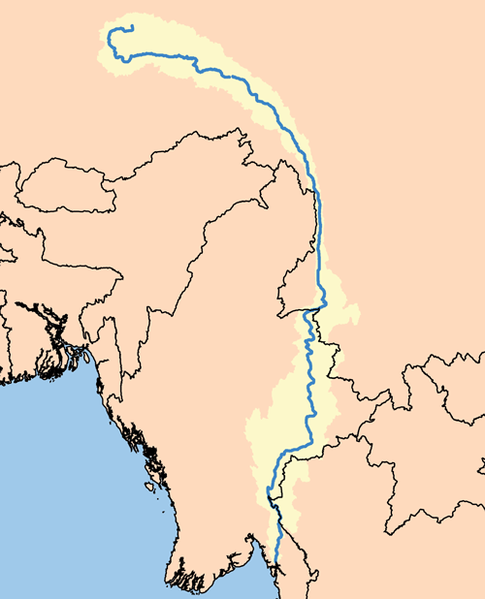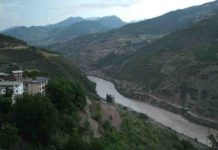
The Salween is a river, about 2,815 kilometres (1,749 mi) long, that flows from the Tibetan Plateau into the Andaman Sea in Southeast Asia. It drains a narrow and mountainous watershed of 324,000 square kilometres (125,000 sq mi) that extends into the countries of China, Burma and Thailand. Steep canyon walls line the swift, powerful and undammed Salween, one of the longest free-flowing rivers in the world. Its extensive drainage basin supports a biodiversity comparable with the Mekong and is home to about 7 million people. In 2003, key parts of the mid-region watershed of the river were included within the Three Parallel Rivers of Yunnan Protected Areas, a UNESCO World Heritage Site.
The people who live on the Salween are relatively isolated from the rest of the world. The river is only navigable up to 90 kilometres (56 mi) from the mouth, and only in the rainy season.
The Burma Road was constructed between 1937 and 1938 during the Second Sino-Japanese War and crossed the river at the Huitong bridge. The Huitong bridge was blown by the retreating Chinese army and the river became the frontline from 1942 to 1944. The Salween Campaign of World War II, was launched in order to liberate occupied China and open the Burma Road again and connect it to the Ledo Road.
Logging began on the mountains surrounding the Salween in the late 20th century, and has damaged the river’s ecology. In recent years, there have been a number of proposals to dam the Salween river in China, prompting environmental concerns and wide opposition. Construction of at least one dam on a tributary of the Salween are currently underway in China’s Yunnan province, and more are expected to follow.
Geography
The Salween rises at 5,450 metres (17,880 ft) in the Qinghai Mountains on the Tibetan Plateau, near the headwaters of the Mekong and Yangtze rivers. It initially flows west but then very shortly makes a great bend to the east, entering the Chinese province of Yunnan and the Three Parallel Rivers of Yunnan Protected Area, a World Heritage Site. Here, the Salween—called the Nu or Nujiang—has been proposed for a series of enormous dams that would theoretically generate more power than Three Gorges Dam, currently the world’s largest hydroelectric station. It then makes a wide southward arc between the Tibetan and Yunnan-Guizhou Plateaus, dropping into what is often known as the “Grand Canyon of the East” or “China’s Grand Canyon”, a 4,000-metre (13,000 ft)-deep gorge that takes it past the Chinese border into northeastern Burma through Shan State and Kayah State,
Mawlamyaing (formerly Moulmein) on the Salween delta
A sharp bend west and another south takes the Salween between the great mountain ranges of eastern Burma, the Daen Lao Range, a subrange of the Shan Hills, followed by the Dawna Hills in the east and the Karen Hills in the west, the river then receives the Pai River also from the left and flows through Salawin National Park to join the Moei River from the east as it approaches Thailand, where it is called the Salawin, forming the Burma-Thailand boundary for about 120 kilometres (75 mi), before re-entering Burma, passing through Karen State and Mon State. The river finally breaks out of its gorge about 250 kilometres (160 mi) from the mouth, and slows down dramatically as it courses through a series of agricultural valleys. About 89 kilometres (55 mi) from the mouth the river finally widens and deepens enough to become navigable for large watercraft. In quick succession it receives Dontham River from the right and Gyaing River from the left, from where the river turns west, flowing under Thanlwin Bridge and widening into a small river delta at Mawlamyaing (formerly Moulmein). This region is the most heavily developed on the river and contains most of the basin’s population.
Near the mouth the river has an average annual discharge of 1,659 cubic metres per second (58,600 cu ft/s), although this varies widely. The river’s base flow is provided by Tibetan glaciers, although it swells dramatically by the time it reaches the lowlands near the coast, especially in monsoon season.
Geology
Much of the watershed consists of one canyon generally paralleling the crustal convergence of the Indian subcontinent and mainland Asia. When India collided with Asia approximately 50 million years ago, many geographical features in the region were forced upwards to enormous heights, forming such landmarks as the Himalayas, Qinghai Shan, the Tibetan Plateau, and the eastern Burma massif. To date, India has pushed the boundary of the original Asian continent nearly 2,000 kilometres (1,200 mi) northwards. Evidence suggests that the southern Tibetan Plateau saw uplift as recently as 15-10 million years ago. The orogenic belt generally trends east to west near the northern part of the Subcontinent and makes a southward arc along with the Salween River on the eastern side. The upper course of the Salween flows through a region dominated by marine sedimentary rock that originally lay at the bottom of the Indian Ocean. This rock was uplifted to a height of thousands of metres by the India-Asia orogeny and is rapidly being eroded away by the Salween. Fault lines are strewn throughout the Salween basin, also generally following the pattern of the mountains and river.
Note : The above story is based on materials provided by Wikipedia










